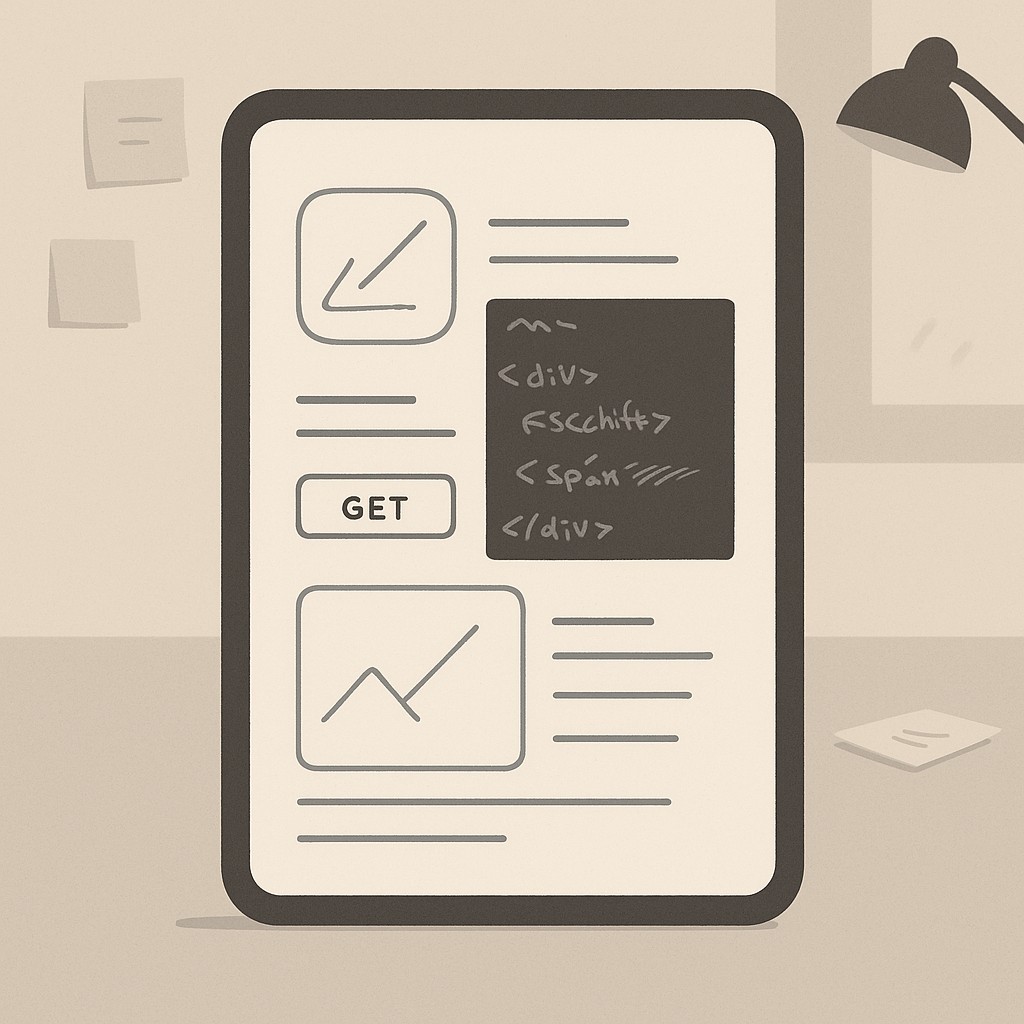Shipping Trumps Credentials: How to Get Hired Without Experience
Shipping Trumps Credentials: How to Get Hired Without Experience

Shipping Trumps Credentials (How My Simple First App Helped Me Get Hired Without Experience)
A little over three months ago, I pushed a Swift file, a stack of duct-taped interface code, and a README I was half-ashamed of to the App Store. I didn’t grow up coding. Honestly, I barely scraped through the submission checklist the first time. Every tiny task felt like it should’ve been a lot simpler than it was. The whole thing was pretty chaotic. But when the app went live—even though it was so basic—that single shipped product did way more for my confidence (and my actual credibility) than any résumé or online course badge.
Seeing my app sitting on a real App Store page was proof, staring back at me, that I’d made something real. That just doesn’t come from a certificate.
I used to think there was some secret sauce or credential that unlocked opportunities. Here’s the wall you hit early on: you’re trying to get hired without experience, but you need a job to get experience. That loop can mess with your head. If you’re stuck on it, trust me, you’re not alone. When you’re just starting, you realize everyone wants evidence you can ship, but almost no one’s willing to hand you that shot up front.
Here’s the actual chain: my app went live, not because I got paid, and definitely not because someone handed me permission. I just decided I wanted it to exist, so I built it. After I threw the code up on X (well, Twitter at the time—I still slip on calling it “X”) and posted a scrappy little video, things rolled quickly.
Within a week, somebody from a nearby business reached out needing something sort of similar, and that message helped me get my first software contract. Built that mini contract, handed it off, and—what do you know—a recruiter DM’d saying they liked how I actually shipped and delivered. Every single one had the same reaction: you finished a thing, and that’s rare. It cracked open a world faster than “proficiency in Swift” ever did. Shipping it meant they didn’t have to gamble on whether I could finish—they could already see it.

The real problem is, gatekeepers don’t want to take risks on people trying to get hired without experience based on “potential” or lines on your CV. They look for actual proof. Shipping, even the simplest project, turns “Can you?” into “You did.”
Experience isn’t a thing you just wait for. It’s something you create.
Why Shipped Projects Lower Hiring Risk (and Make You the Safer Bet)
Hiring, from a manager’s side, feels pretty high-stakes. Most of them are haunted by the idea of someone promising the moon, only to disappear or stall once the real work hits. If you can show a shipped product that anyone can poke at, it settles most of their nerves. With a finished build open to the public, you cut out almost all guessing. That’s the whole dynamic: putting out something real means the proof speaks for itself. If a reviewer can run your code, skim a live demo, or read your README, you don’t need to convince them with words—they’re already convinced by what they see.
Credentials have their place. They show you studied, learned. But that doesn’t mean you ship. Portfolio projects flip it: a degree proves you learned; a portfolio proves you actually build. In hiring land, gatekeepers care what shows up in front of users. The field is already shifting. Right now, 60% of developers, 53% of execs, and 49% of recruiters say degrees shouldn’t be required for tech jobs—and there are another 1.4 million new roles for people without college degrees popping up in the next five years. The change isn’t hypothetical.
It’s tempting to make every project look “impressive.” Honestly, though, smaller focused builds actually stand out for being more usable. Nobody wants to get lost in someone’s magnum opus of spaghetti code. If you shipped something real, and your README walks them through it, you show reliability without having to say anything extra. Just make your work scannable. Ironically, the less convoluted your project, the less work for whoever’s checking things out.
So skip the waiting game. You don’t need sign-off from anyone else to start building experience. It’s not something handed to you—it’s what you make, by doing the work.
How to Build Credible Proof with One Simple Public Project Per Month
Here’s what I do: pick one problem per month. Something you could build in a weekend, nothing wild. Knock out a minimum-viable product (and yes, “minimum” for me sometimes meant the UI was honestly ugly). Push your code to a public GitHub repo. Write a README so even a rushed reviewer gets what it does. Then put that app on a free cloud URL—Vercel, Render, Netlify, whatever fits. After that, record a quick walkthrough video. I try for around 90 seconds, never more than two minutes. Link that video right at the top of your README.
Now when you apply anywhere, instead of a wall of bullet points, you send one link that helps you land your first developer job. Reviewers can actually see proof you build and ship—not just a list.
Here’s what matters most: pick problems you can actually solve in a weekend. That keeps momentum up and prevents that slow slide where you “improve” your builds until you never finish. Most of my first projects ran off free-tier hosting, with maybe six files and zero bells or whistles. Ignore the little voice that says “this isn’t impressive.” Momentum beats magnitude.
Make everything inspectable. If someone can click a live demo, run through basic flows, and see results without downloading or poking at files, that’s huge. Seriously, a dead link just kills interest. Live demos do the opposite.
Publicly document projects like a human, not a robot. Start your README with what the project does, quick steps to run it, and a note about why you built it that way. Chuck in a screenshot if you have one; most folks scan with their eyes, not their brain. Link your walkthrough video at the very top. That little video is actually the callback to my original app post—not planned, but it keeps working. Those first three months, I doubted anyone watched. Turns out, they did, and sometimes replayed. README clarity makes your side project actual proof someone can use.
Do this once a month. Stack up projects at your pace—no big rush, just keep moving. Momentum builds. I remember last winter, pitching live projects and hearing nothing. By spring, I had two contracts and three interviews spinning off the same repo trail. Shipping small, clear projects builds credibility that compounds quickly.
How to Package and Share Projects So Reviewers Pay Attention
Fastest way to prove you built something is with a two-minute demo video. Loom works. Any screen recorder works. Demo the shipped product, click around, talk about choices you made, what’s sloppy, what’s clever. It saves reviewers a mountain of time. They don’t dig through code trying to see if you actually get it. If they’re skimming, they catch your thought process in seconds.
Make your portfolio links hard to miss and spotlight that you build and ship projects. Put your GitHub and your demo URL in the first bullets on your résumé, thread them into your intro note, and add one promise: “Proof I build and ship.” Click goes to something clean, not chaos.
Last week, something weird happened. Total stranger DMed me about a bug in a CLI tool I’d thrown up months earlier. They’d found it, ran it, hit a weird edge case, and shot me a note before I even realized anyone was using it. That’s human attention for you—it arrives sideways. The stuff you put out actually gets seen, just not always the way you expect.
Frame every README and link with the reviewer’s risk in mind. “Here’s everything, click and skim in two minutes.” Credentials are overhyped. Actual proof is all anyone wants.
If you’re shipping monthly projects, use our AI builder portfolio to quickly draft clean READMEs, demo scripts, and outreach posts, so your proof-of-work is clear and shareable in minutes.
Common Doubts and How to Prove Yourself Anyway
People always ask about time. I used to think bigger meant better, and that I’d need weeks for anything “real.” Turns out, a weekend-scale build beats nothing every time. Simple projects, just finished and public, get mileage. Most reviewers trust public code. Nobody trusts a claim.
Putting out unfinished or not-perfect work is awkward, for sure. Sometimes, sharing half-baked code publicly makes me cringe a little. But you learn faster because people actually react. First few times I put projects out, feedback weirded me out. Now, it helps—usually.
Kick off with something tiny and ship it this month. Don’t wait. Build your own experience, link it everywhere, see what comes next. That’s how doors open—one simple project at a time.
This is the expected criteria for your final answer: Free-form (raw) output is acceptable. Follow the task description carefully.
you MUST return the actual complete content as the final answer, not a summary.
Begin! This is VERY important to you, use the tools available and give your best Final Answer, your job depends on it!
Enjoyed this post? For more insights on engineering leadership, mindful productivity, and navigating the modern workday, follow me on LinkedIn to stay inspired and join the conversation.
You can also view and comment on the original post here .
